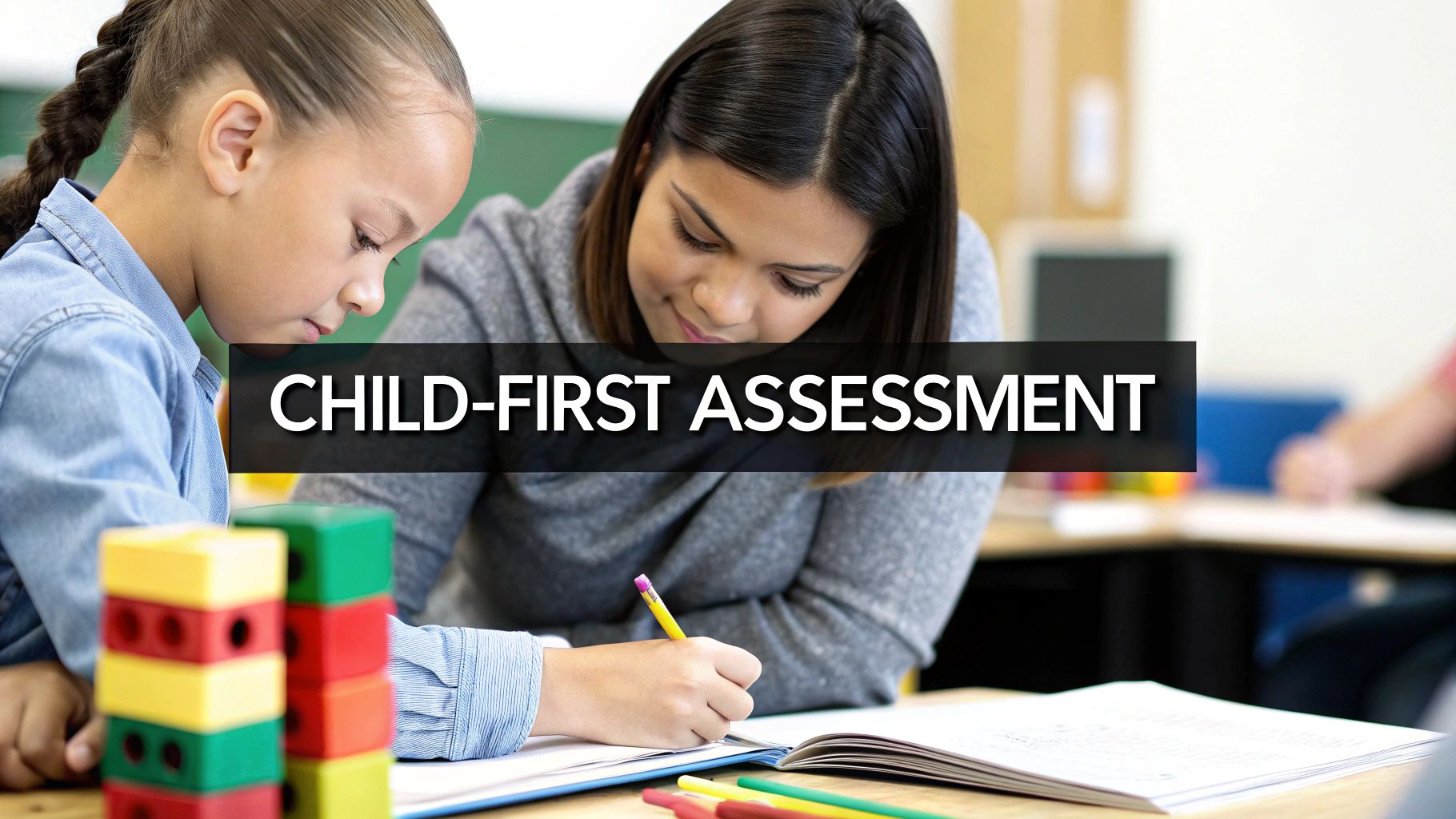An assessment for education is not just about grades or test scores; it's a supportive tool that provides a roadmap for a child's unique learning journey. It moves beyond simply measuring what a student knows to discovering how they learn best and what they need to truly flourish, making them feel seen, valued, and understood.
Why Traditional Grades Are Not Enough
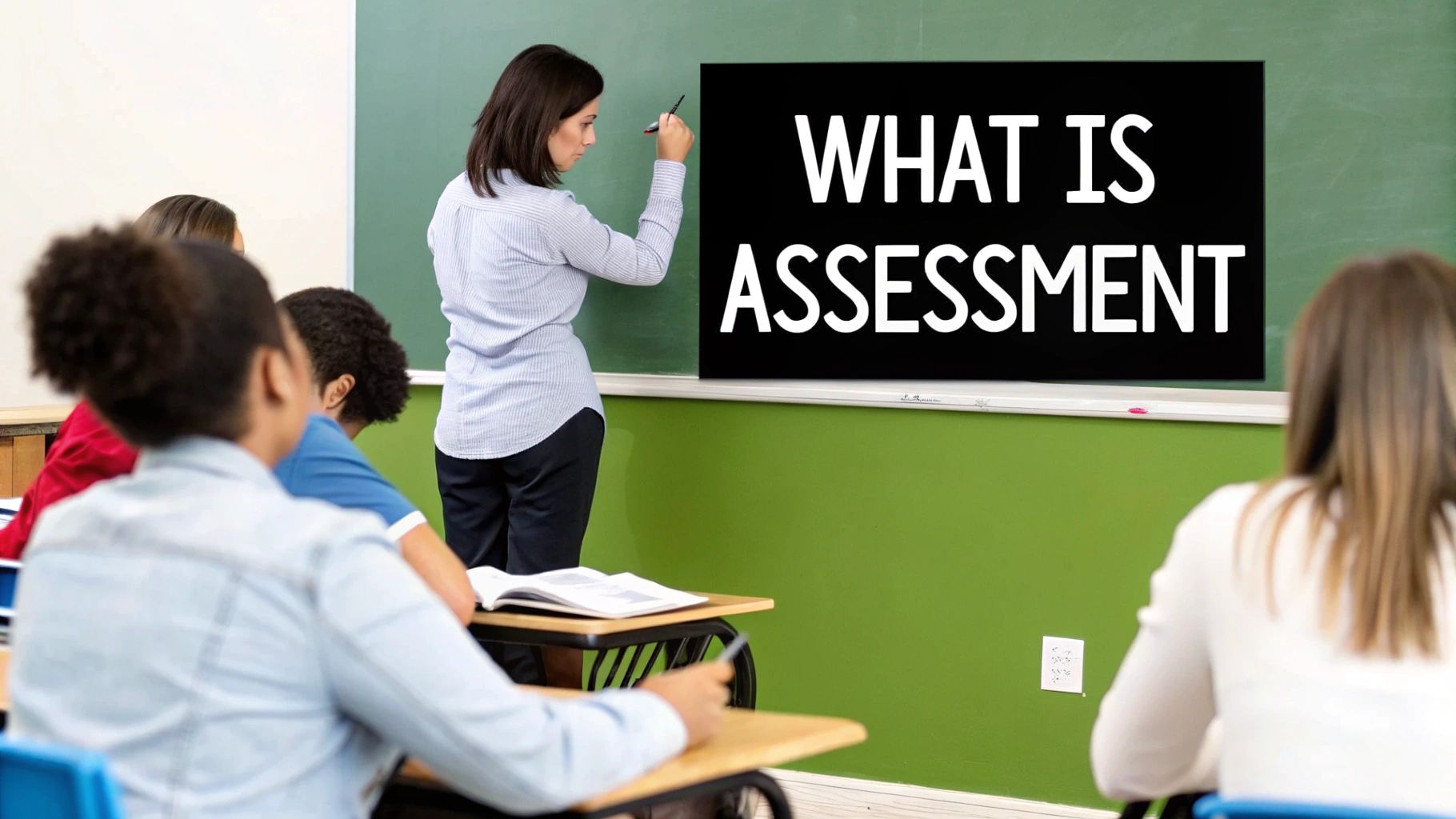
For many, the word "assessment" brings a knot of anxiety to the stomach. We picture a silent exam hall, a ticking clock, and a single letter or number that feels like a final judgment. This traditional view of assessment often places immense pressure on children, tying their self-worth to a score on a page and causing sleepless nights for both them and their parents.
But what if we reframed our perspective? Imagine assessment not as a verdict, but as a conversation. It's a way for educators and parents to understand a child's world, celebrate their strengths, and gently illuminate areas where they need more support. When we put the child's emotional and academic needs at the centre, assessment transforms from a source of stress into a powerful instrument for building confidence and a genuine love for learning.
Moving Beyond a Single Score
A single grade on a report card tells us very little about the journey. It doesn't show the spark of curiosity in a child's eyes during a science experiment, the perseverance they showed mastering a difficult maths problem, or the creative way they solved a challenge. A child-first approach to assessment for education aims to capture this entire story.
This approach acknowledges that every child is on a unique path. It prioritises discovering how they think and what motivates them, rather than just what they can memorise for a test. For example, a child who struggles to write an essay might be able to create an incredible video presentation on the same topic. It’s about asking bigger, more compassionate questions:
- Does this child thrive with hands-on projects that let them get their hands dirty?
- Do they express their brilliant ideas best through writing, speaking, or even drawing?
- What feedback will help them feel encouraged instead of defeated?
By focusing on the process over the outcome, we send a powerful message to our children: your effort, your creativity, and your growth matter more than any single mark. This builds resilience and fosters an environment where it's safe to make mistakes—which is where the deepest learning happens.
The Evolution of Assessment in the UK
This shift towards a more holistic view of assessment for education isn't new; it reflects a long history of change. In the UK, assessment systems have evolved significantly, directly impacting student achievement over decades. For example, between the 1950s and the late 1980s, the proportion of school leavers achieving five or more O-level or GCSE passes grew from just over 10% to nearly 30%.
This progress was driven by changes like the introduction of the GCSE system, which moved away from a rigid grading curve to one that could better recognise widespread student improvement. You can discover more about how these historical shifts in assessment have shaped student success in the UK.
Ultimately, seeing assessment through a child’s eyes changes everything. It’s no longer about catching them out but about lifting them up. It’s about providing a clear, supportive roadmap that helps every child find their way to success, feeling capable and confident every step of the way.
Formative vs Summative Assessment Explained
To really get to grips with how modern assessment for education can help a child, we need to look at its two main forms. Think of a dedicated coach training a young athlete for a big competition. The way that coach works with the athlete every single day is very different from the final championship event, yet both are absolutely essential for success. This is the heart of the difference between formative and summative assessment.
Formative assessment is the day-to-day practice. It's the coach offering gentle tips on technique, giving a word of encouragement after a tough drill, and tweaking the training plan in real-time to build new skills. It’s an ongoing conversation, designed to nurture growth moment by moment. It's not about judgement; it's about helping a child feel seen and supported.
Summative assessment, on the other hand, is the final championship match. It’s that big moment that shows just how well all the training, practice, and coaching paid off under pressure. It gives a clear snapshot of the athlete's abilities at that specific point in time. Both are vital for building a confident, skilled, and resilient learner.
Formative Assessment: The Supportive Coach
Formative assessment is all about checking in. It’s the low-stakes, supportive feedback that helps a child understand where they are and what the next step is, all without the fear of failure. Imagine a teacher walking around the classroom, glancing over a child’s shoulder as they write a story, and quietly asking, “That’s a brilliant start! I wonder what amazing adventure happens next?”
This type of assessment is designed to make learning visible and to empower the child. It answers the questions, "How am I doing?" and "What should I do now?" in a way that feels helpful, not critical.
Practical Examples of Formative Assessment:
- Quick Quizzes: A short, ungraded pop quiz where the goal is just to see what stuck. For instance, using coloured cards (red, yellow, green) for students to show their confidence level with a new maths concept.
- Exit Tickets: Asking students to write one thing they learned on a sticky note before leaving class, giving the teacher instant insight and the child a moment to reflect.
- Peer Feedback: Students sharing their creative writing with a partner to get friendly suggestions. This builds community and shows them their words have an impact on others.
- Observation: A teacher noticing that a child is getting frustrated with a task and gently stepping in to offer help, not judgement.
Formative assessment is the heart of a child-centred approach. It tells a child, "I see your effort, and I am here to help you grow." This continuous loop of action and feedback builds trust and makes the child an active participant in their own learning journey.
Summative Assessment: The Championship Game
If formative assessment is the ongoing training, then summative assessment is the final performance. It happens at the end of a learning period—like a unit, a term, or a whole year—to measure what a student has ultimately learned. While it often takes the form of a test, it certainly doesn't have to.
The key is that it summarises the learning that has taken place. For a child, this can be a chance to proudly show off their new skills and knowledge. When it’s properly balanced with ongoing formative support, a summative assessment feels less like a scary final judgement and more like a celebration of their hard work. It answers the question, "What have I achieved?" with a sense of pride.
To see how these two approaches work in a real-world setting, let's look at some child-focused examples.
Formative vs Summative Assessment in Practice
| Assessment Type | What It Looks Like | How It Helps the Child |
|---|---|---|
| Formative | A teacher asks a child to explain their thinking on a maths problem out loud. | It helps the child feel heard and allows the teacher to spot and fix a misunderstanding on the spot, preventing future frustration. |
| Summative | A child completes an end-of-term maths test with questions from the whole term. | It gives the child a sense of accomplishment and a clear picture of which topics they have mastered, boosting their confidence. |
| Formative | Students share drafts of a story with a partner to get 'two stars and a wish' (two positives, one suggestion). | It teaches the child how to give and receive constructive feedback in a safe, friendly way, making them feel like a real author. |
| Summative | A student submits a final polished creative writing portfolio at the end of the year. | It showcases the child’s progress and creativity over time, becoming a piece of work they can be incredibly proud of. |
As you can see, one isn't "better" than the other; they simply have different, equally important jobs in helping a child learn and grow.
The following infographic illustrates how the constant feedback from these assessments drives engagement and improves learning outcomes.
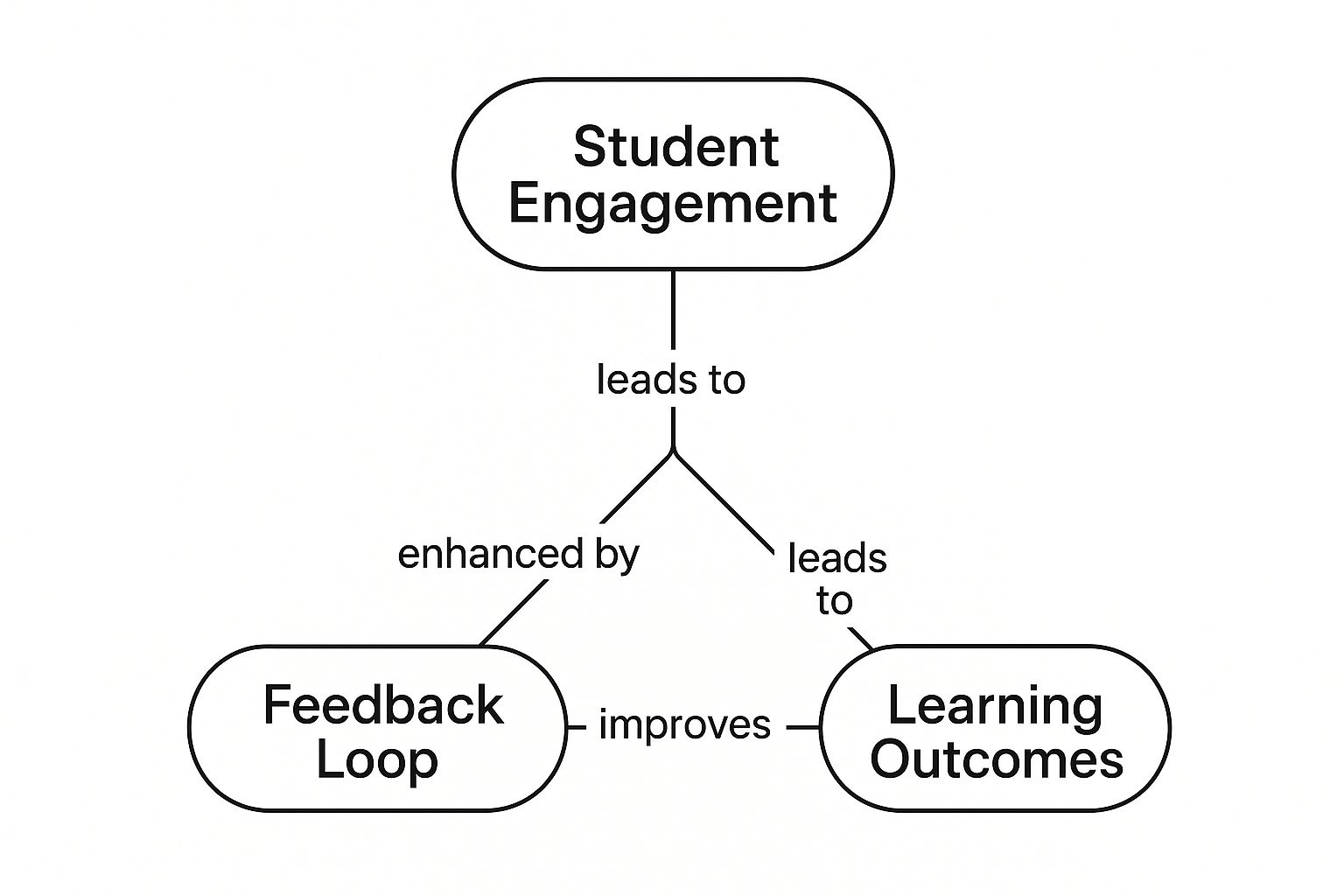
This shows that the feedback loop created by both types of assessment is the engine that connects a child's engagement directly to their success. A healthy balance ensures we are not just measuring the final score, but actively improving the entire learning process. This is how we build confident, lifelong learners who feel supported rather than constantly judged.
Child-Centred Assessment in Action
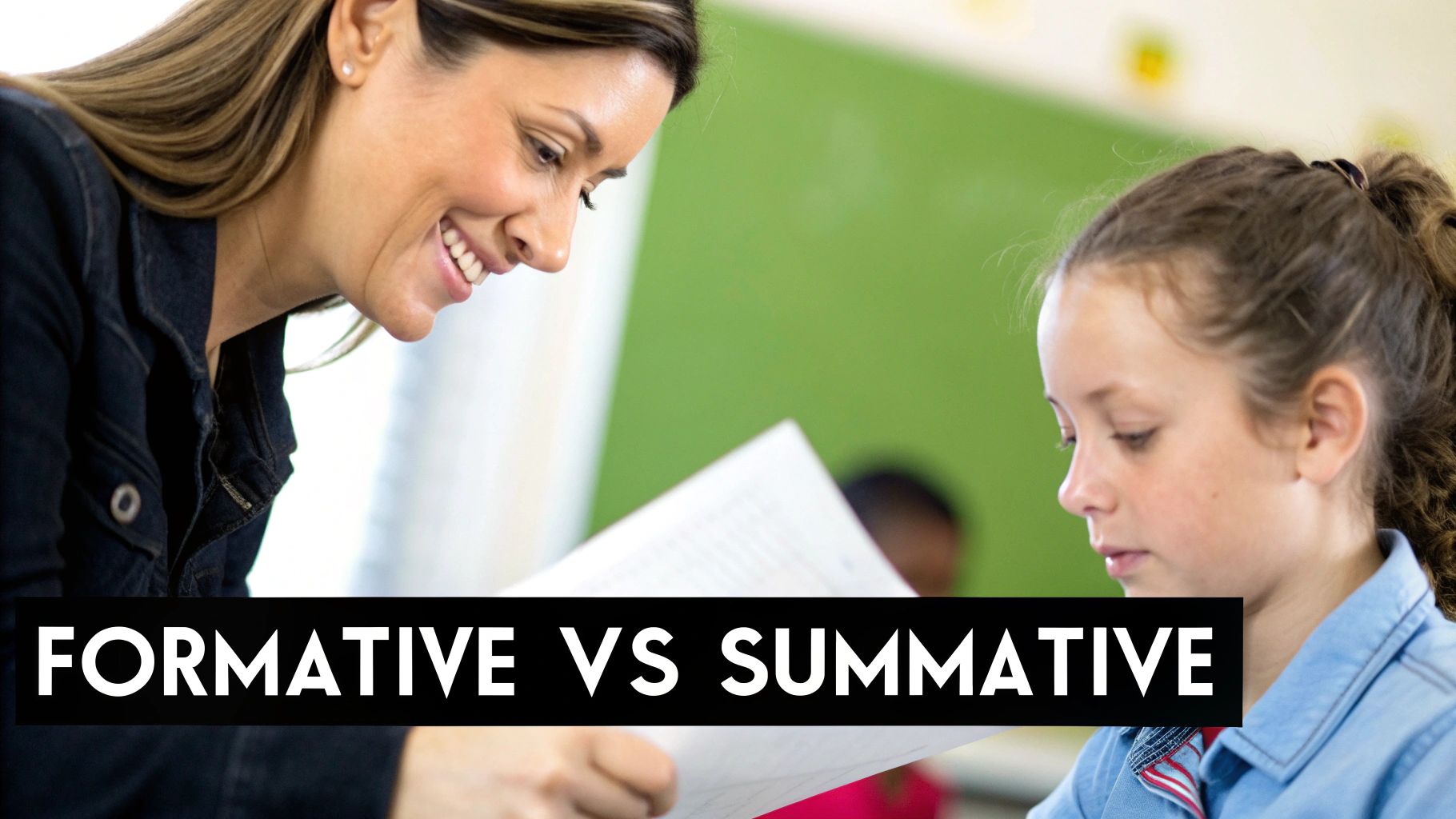
It’s one thing to talk about assessment in theory, but its real power comes to life when you see it through a child’s eyes. When we stop obsessing over a single test score and look at the whole child, we create a space for them to show us what they can really do. This is where assessment becomes a tool for building confidence, not just measuring knowledge.
Let’s imagine Sophie, a bright and creative Year 4 student who gets incredibly anxious about written tests. The pressure of sitting silently and writing down answers makes her mind go blank, even when she knows the material inside and out. Her test results just don’t match her deep understanding of her history topic: the Romans. It's heartbreaking for her and her parents to see her passion not reflected in her grades.
So, instead of another exam paper, her teacher tries something different. Sophie’s task is to build a model of a Roman villa and give a short presentation on its features. Instantly, her anxiety vanishes, replaced by pure excitement. She spends hours crafting the atrium, the peristylium, and the cubicula, her hands busy and her mind buzzing with ideas.
When she presents her model, Sophie doesn’t just recite facts. She tells a story. She explains how a Roman family would live there, why the kitchen was in a specific spot, and what the mosaics represented. This project allowed her to showcase her historical knowledge, her creativity, and her public speaking skills—talents a written test would have completely ignored. For Sophie, this wasn’t an exam; it was a celebration of what she had learned. She felt smart, capable, and proud.
Capturing Growth with Digital Portfolios
Now, think about Leo, a Year 10 student who loves his science lessons but struggles to see the bigger picture. His folder is just a jumble of worksheets and lab reports, and he feels his effort is only ever judged by the mark on each individual piece of work. This leaves him feeling disconnected and unmotivated.
To help him connect the dots, his teacher introduces him to a digital portfolio. This is Leo’s personal online space where he can upload photos of his experiments, short videos of himself explaining a hypothesis, and written reflections on what went well and what he’d change next time.
This simple shift completely changes his relationship with his own learning. Instead of just ticking off tasks, Leo starts thinking like a scientist. He spots patterns in his results and works with his teacher to set personal goals based on his reflections. His portfolio becomes a living record of his journey, a powerful tool for self-assessment, and something he can feel genuinely proud of. He's no longer just a student completing tasks; he's a young scientist building a body of work.
"A blog or digital portfolio encourages students to read posts, comment on the work of others and reflect on their learning as it develops. It makes the learning process explicit, clear and visible."
This kind of ongoing, reflective work is a cornerstone of modern education. It moves beyond isolated tasks and helps students build a much deeper understanding of their own learning journey. It’s an approach that works particularly well in settings like UK homeschooling online, where personalised learning paths are the key to success.
Why These Methods Work
Child-centred assessments like projects and portfolios are so effective because they honour the individual. They give students multiple ways to show what they know, which is absolutely crucial for building genuine confidence and self-worth.
The idea behind it is simple but powerful:
- They celebrate different talents: Not every child is a great test-taker, but they might be a fantastic artist, a compelling speaker, or a brilliant problem-solver. These methods let them shine.
- They focus on growth: A portfolio shows progress over time, teaching children that learning is a journey, not just a series of tests. They can literally see how far they've come.
- They reduce anxiety: By taking away the high-stakes pressure of a single exam, we give children the freedom to explore, create, and learn without fear.
Understanding the impact of these methods is vital, especially when we look at the bigger picture. In the UK, data on pupil progression reveals a complex landscape. Headline performance measures aren't always comparable across the four nations because of different qualifications frameworks. Statistics for 2022/23 show rising pupil numbers and the ongoing challenge of assessing diverse educational outcomes, which only highlights why flexible, individualised assessment is so important. You can explore the full education and training statistics for the UK to see the data for yourself.
By embracing stories like Sophie’s and Leo’s, we move towards an education system where every child truly has the chance to shine.
How Technology Supports Personalised Assessment
Technology offers some incredible tools to make assessment a more individual, less intimidating, and far more insightful experience for everyone. For a child, the fear of getting an answer wrong in front of their peers can be paralysing. Digital tools help create a safer, more private space for them to learn and, just as importantly, to make mistakes.
Imagine a child working on a maths problem on a tablet. If they make an error, the platform doesn't just flash a big red cross; it might offer a gentle hint or a short video explaining the concept again. For instance, a friendly animated character could pop up and say, "That's a tricky one! Have you tried carrying the one?" This instant, private feedback helps them correct their own thinking without any sense of public failure. It transforms assessment from a judgement into a helpful guide, building confidence with every click.
Adaptive Assessments That Grow with Your Child
One of the most powerful uses of technology is adaptive assessment. Think of it as a personal tutor that understands exactly what a child needs at any given moment. These aren't static, one-size-fits-all tests. Instead, the software adjusts the difficulty of questions based on a student's previous answers.
This creates a perfectly tailored challenge.
- If a student answers a question correctly, the next one will be slightly more difficult, gently pushing them to expand their skills. This makes them feel smart and capable.
- If they struggle with a concept, the system provides simpler questions to reinforce the foundational knowledge they need before moving on, preventing them from feeling overwhelmed.
This dynamic process ensures a child is always in their optimal learning zone—challenged enough to stay engaged, but not so overwhelmed that they give up. The feeling for the child is one of empowerment; the assessment feels like it is working with them, not against them.
An adaptive test respects a child’s individual pace. It acknowledges that learning isn't a straight line and gives them the precise level of support they need to keep moving forward, turning potential frustration into a feeling of accomplishment.
Making Assessment Fun Through Gamification
Who says assessment has to feel like a test? Technology allows us to embed learning checks into activities that children genuinely enjoy. Educational games are a fantastic example of this. As a child builds a virtual city, solves a puzzle, or embarks on a digital quest, they are simultaneously demonstrating their knowledge of geography, logic, or literacy.
For example, in a game about ancient Egypt, a child might need to correctly answer questions about pharaohs to earn the "gold" needed to build a pyramid. They get so absorbed in the fun of the game that they often don't even realise their skills are being assessed. The data collected provides the educator with rich insights into the child's abilities, all while the child simply feels like they are playing. This is particularly effective in different learning environments; for more ideas on structuring learning at home, you can check out our comprehensive guide on how to homeschool in the UK.
For practical strategies, exploring how assessing learning with interactive video can boost comprehension is a great next step. These digital tools move beyond traditional quiz formats and help teachers and parents understand each child's needs on a much deeper level, fostering an environment where assessment becomes a seamless and positive part of the learning adventure.
Assessment for Higher Education and Future Careers
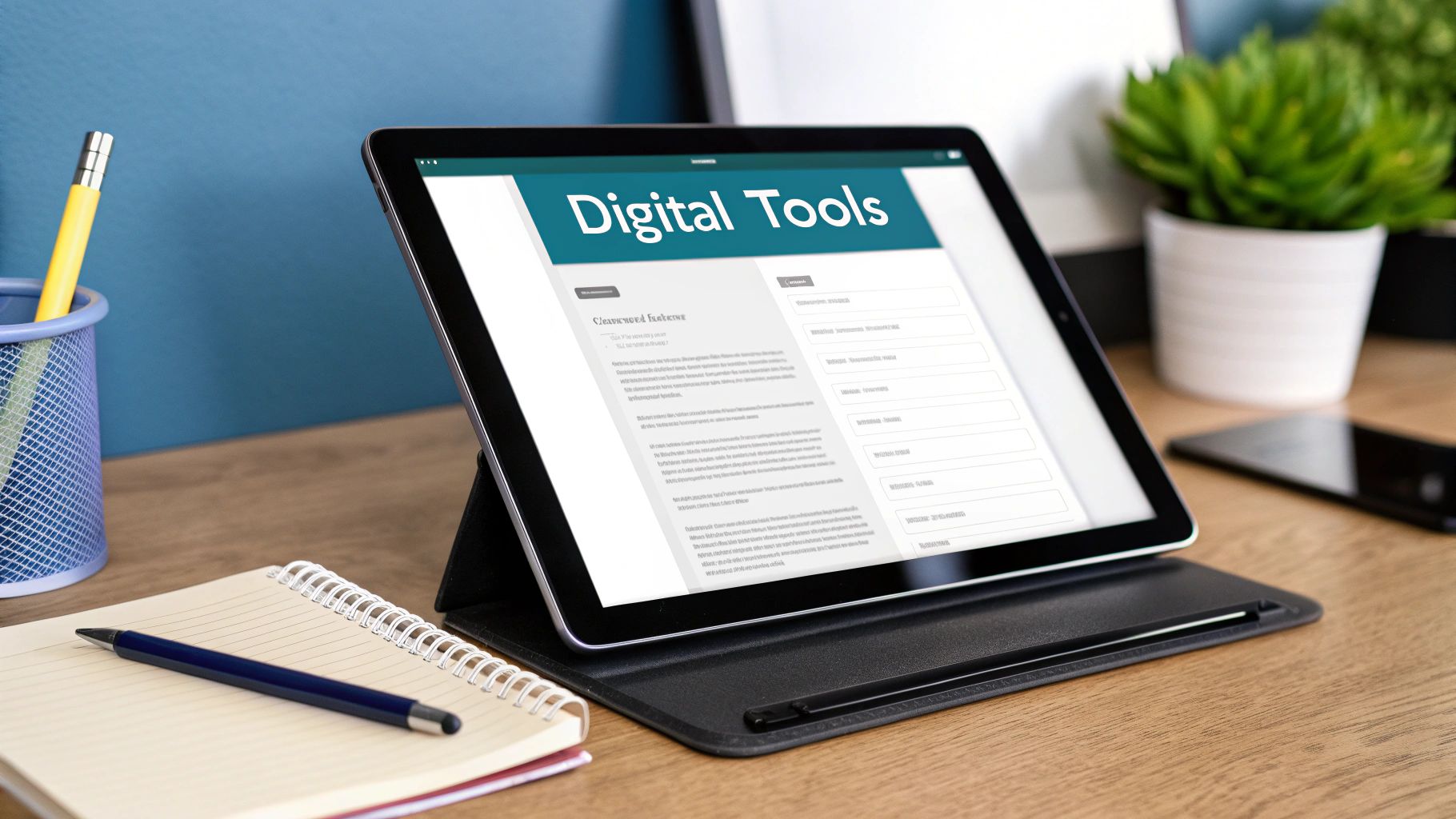
When a student makes the leap from school to higher education, the whole game changes. And so does assessment. It’s no longer just about reciting facts or passing exams; it’s about building a bridge between academic theory and a real-world career. For a young person stepping into this new world—often with a mix of excitement and trepidation—the focus shifts from what they know to what they can do with that knowledge.
Universities and colleges aren't just in the business of awarding degrees. They use assessment to actively shape students into the professionals of tomorrow. The emphasis moves squarely onto building a student's capacity for critical thinking, complex problem-solving, and effective collaboration. Suddenly, every assessment becomes an opportunity to build a portfolio of skills that speaks directly to future employers.
Beyond the Final Exam
While traditional exams still have their place, assessment in higher education is increasingly designed to mirror the tasks and challenges of the modern workplace. It’s a deliberate strategy to cultivate the very abilities that employers are desperate for, helping students feel confident and prepared for their professional lives.
This approach puts the student’s journey at the very centre of the experience, ensuring education is a direct and meaningful preparation for a fulfilling career. The goal is to close the gap between the lecture hall and the workplace.
Key assessment methods that build career readiness include:
- Dissertations and Major Research Projects: These aren't just long essays. They’re a test of a student’s ability to manage a long-term project, conduct independent research, analyse complex data, and build a watertight, evidence-based argument—skills that are gold dust in countless professions.
- Practical Placements and Internships: This is where the rubber meets the road. Assessment happens in a real work environment, evaluating a student not just on theory but on their professionalism, adaptability, and ability to apply learning to genuine industry problems. A student might be asked to present their findings from an internship to a panel, simulating a real boardroom meeting.
- Collaborative Group Projects: These tasks directly measure teamwork, communication, and leadership. Students learn to navigate different personalities and work towards a common goal, just as they will in their future teams.
This style of assessment for education helps a student build a tangible showcase of what they’re capable of. A well-executed project or a glowing report from a placement becomes a powerful story to tell in a job interview, proving they’re ready for the role.
Measuring What Matters for the Future
This intense focus on employability is now reflected in how UK higher education outcomes are measured. The official statistics go far beyond simple degree classifications. Metrics now include graduate employment rates, salary levels, and student satisfaction, all broken down by course and institution. It shows a clear trend: evaluating how well universities are actually preparing students for life after graduation. You can discover more about how student outcomes and diversity are tracked in UK higher education.
Ultimately, assessment in higher education is about empowerment. It gives students the chance to prove they can think critically, solve problems creatively, and work effectively with others. It helps them build a professional identity and a body of work that gives them the confidence to step into their chosen career, ready to make a real impact from day one.
Building a Positive Assessment Culture at Home and School
Creating a supportive environment around assessment is one of the most powerful things we can do for our children. It’s about making a fundamental shift in how we talk about schoolwork, moving away from the anxious question, "What mark did you get?" to the more curious and compassionate, "What did you learn today?" This small change helps a child see assessment not as a final judgment on their abilities, but as a helpful signpost on their learning journey.
When a child brings home a piece of work, our immediate reaction is incredibly important. Instead of honing in on the score, we can celebrate their effort and grit. A simple phrase like, "I can see how hard you worked on this," validates the process and reinforces that growth is what truly matters, not just the grade. This builds psychological safety, teaching them that our love and pride aren't tied to their performance.
This approach turns feedback from something to be feared into a welcome gift. It helps children understand that suggestions for improvement aren't criticisms, but valuable clues that help them get better. When parents and educators work together, we can build a culture where every assessment is a stepping stone, not a stumbling block.
Shifting the Conversation at Home
Forging this positive culture starts with small, consistent changes in how we talk about school. It’s about being intentional with our words to dial down the pressure and build up a child’s inner confidence.
Here are a few practical ways to reframe the assessment chat:
- Focus on the Process, Not Just the Result: Ask questions that explore their experience. Instead of "Did you get it all right?", try asking, "What was the most interesting part of that project?" or "What was the trickiest bit, and how did you figure it out? That sounds tough!"
- Celebrate Mistakes as Learning Opportunities: If a child gets something wrong, try not to show disappointment. You can frame it as a discovery: "That's brilliant! Now we know exactly what to practise next. Mistakes are just proof that you're trying something new."
- Praise Specific Efforts: Move beyond generic praise like "You're so smart." Instead, be specific: "I was so impressed with how you didn't give up on that difficult maths problem," or "The way you organised your ideas in this essay is really clear. It helped me understand your point perfectly."
By focusing our praise on effort, strategy, and resilience, we help our children develop a growth mindset. This is the belief that their abilities can be developed through dedication and hard work—a core principle for lifelong learning and emotional wellbeing.
This nurturing approach is especially vital in more flexible learning environments. For families exploring different educational paths, creating this supportive atmosphere at home is key. Our guide to online home education in the UK offers more insights into building a successful and positive learning environment outside the traditional classroom.
Partnering with School to Reduce Anxiety
A united front between home and school is crucial for helping a child feel secure and understood. Open communication with teachers can demystify the assessment process and make sure everyone is working towards the same goal: supporting the child.
When you discuss results with a teacher, approach it as a team. Ask collaborative questions like, "What do these results tell us about my child's strengths?" and "What strategies can we use at home to support what you're doing in class?" This partnership shows the child that the adults in their life are on their side, working together. By doing this, we empower children to view every assessment for education as just one more positive step on their exciting journey of discovery.
Frequently Asked Questions
Navigating the world of educational assessment can bring up a lot of questions. It's completely normal for parents and educators to wonder how to best support a child's learning journey without adding to their stress. Here are some straightforward answers to the most common concerns, all focused on putting your child’s needs and emotional wellbeing first.
How Can I Help My Child with Test Anxiety?
It’s heart-wrenching to see your child distressed by tests. The key is to shift the focus from the outcome to the process and their perspective. Help them understand that a test is just one snapshot of their learning, not a judgement on their worth as a person. It certainly doesn't define how smart, creative, or wonderful you know they are.
Before a test, try practicing simple relaxation techniques together, like taking deep breaths or visualising a calm, happy place. A good night's sleep and a proper breakfast also make a huge difference. Afterwards, the most important thing you can do is celebrate their effort, no matter the score. Frame the whole experience as a chance for them to show what they've learned, not as a scary event to be dreaded.
What Is the Difference Between Assessment and Testing?
This is a fantastic question, and the answer gets right to the heart of what child-first learning is all about. A test is a specific event—usually a formal exam or a quiz designed to measure knowledge at a single point in time. Think of it as one piece of data.
Assessment for education, on the other hand, is the much bigger, ongoing process. It includes tests, of course, but it also covers everything else: observing a child during a live lesson, looking through their project portfolio, listening to them explain their ideas, and having supportive conversations about their progress.
Think of it like this: a test is a single photograph. It captures just one moment. A full assessment is the whole family photo album, showing growth, personality, and the entire story over time.
How Should I Talk to a Teacher About My Child's Assessment Results?
The best way to approach this is to see the teacher as your partner. When you start the conversation, aim for collaboration and working together for your child's benefit. Instead of leading with a challenge, begin with open, curious questions that invite a genuine discussion.
You could try saying something like:
- "Could you help me understand what these results tell us about my child’s learning journey?"
- "I'd love to hear about where you see their biggest strengths at the moment."
- "What are the next steps we could take, both at school and at home, to support their progress in this area?"
Adopting this collaborative tone shows you’re a team focused on the same goal: helping your child thrive. It shifts the conversation from being just about scores to creating a forward-looking plan that centres on your child's individual needs and makes them feel supported by all the adults in their life.
Are Standardised Tests Still Important?
Yes, in a way. Standardised tests do still have a role. They offer a broad benchmark that helps schools and educational bodies understand performance across a whole region or country. For parents, they can provide one specific data point for comparison.
However, a child-first approach to assessment for education means recognising that these tests are just one piece of a much larger and more colourful puzzle. A single test score can be influenced by countless factors, from a child simply having an off day to feeling anxious.
The results from these tests should always be considered alongside a rich variety of other information—like project work, class participation, and teacher observations—to build a complete, accurate, and truly fair picture of a child’s incredible abilities and potential.
At Queens Online School, we believe in a holistic and child-centred approach to assessment. Our live, interactive classes and personalised learning paths ensure every student is understood, supported, and empowered to reach their full potential. Discover how our accredited online British curriculum can transform your child’s educational journey.

